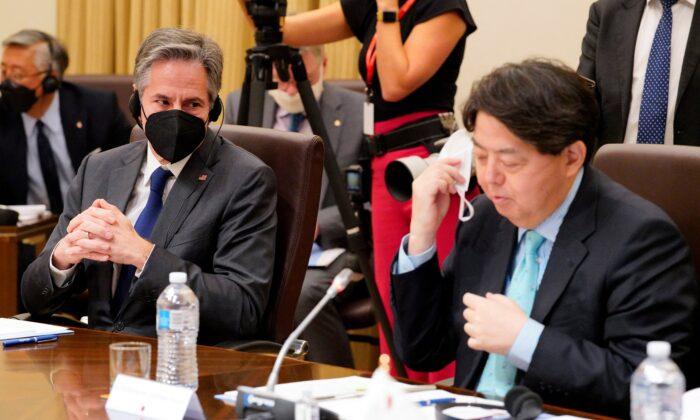The United States and Japan on Jan. 11 unveiled new plans to strengthen their alliance amid growing threats from North Korea and communist China, including extending security cooperation to outer space.
Chinese Regime Is a ‘Strategic Challenge’
“We agree that the PRC [People’s Republic of China] is the greatest shared strategic challenge that we and our allies and partners face,” Blinken said.Hayashi, meanwhile, said that China’s communist regime “presents an unprecedented and the greatest strategic challenge,” adding that its “foreign policy to recreate international order to serve its self-interest is a grave concern for the Japan-U.S. Alliance and for the whole of the international community.”
The four officials said that Japan and the United States would “continue to be united” in raising objections against the Chinese regime’s attempts to “change [the] status quo in the East China Sea,” including its attempts to undermine Japan’s administration of the Senkaku Islands, uninhabited islands in the East China Sea located northeast of Taiwan.

China has claimed the Senkaku Islands as its sovereign territory.
The four leaders also confirmed their strong opposition against “unlawful claims and coercive and provocative efforts and actions by China in the South China Sea,” and the importance of maintaining peace and stability of the Taiwan Straits, according to the statement.
Elsewhere, officials said that the 12th Marine Regiment, an artillery regiment, will remain in Japan’s southern island of Okinawa and be redesignated as the 12th Marine Littoral Regiment by 2025.
The regiment will be equipped with advanced intelligence, surveillance, and reconnaissance, as well as anti-ship and transportation capabilities, in case of a Chinese incursion into Taiwan or other hostile acts by the Chinese regime, according to officials.
US–Japan Cooperation in Space
Blinken stated that he and Hayashi are set to sign a new agreement later this week at NASA on U.S.–Japan cooperation in space.“This agreement has been a decade in the making; it covers everything from joint research to working together to land the first woman and person of color on the Moon,” Blinken said.
Threats From North Korea
Outside of China, the officials reaffirmed their “unwavering commitment” toward the complete denuclearization of North Korea. At the same time, the United States also strongly endorsed Japan’s decision to acquire ship-launched U.S. Tomahawk cruise missiles made by Raytheon Technologies to give it “counterstrike capability” amid concerns of an impending attack by the Chinese regime or North Korea.
North Korea fired more than 60 missiles last year, including ballistic missiles that passed over Japan in October 2022. Meanwhile, during military drills in August 2022, the Chinese regime fired several missiles that landed in waters near Taiwan, which neighbors Japan.
During the Jan. 11 meeting with his Japanese counterparts, Blinken said the two nations are working with the rest of their G-7 partners to impose further coordinated sanctions on Russia while simultaneously working to help Ukraine “repair, restore, and defend” the country’s embattled energy grid.
The Jan. 11 meeting between the United States and Japan comes as U.S. President Joe Biden is set to host Japanese Prime Minister Fumio Kishida at the White House on Jan. 13, where the two are set to discuss a number of regional and international issues.





